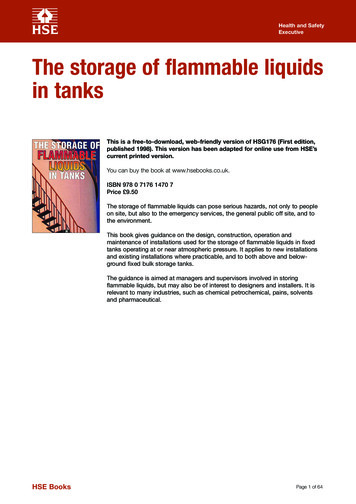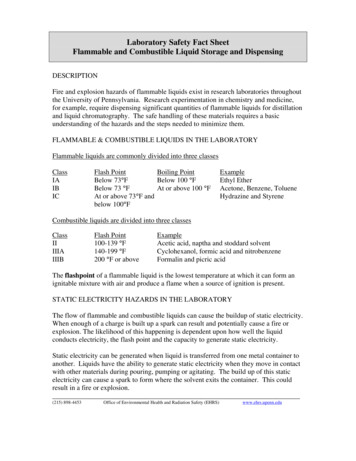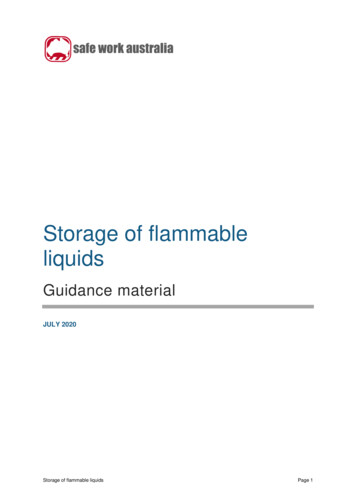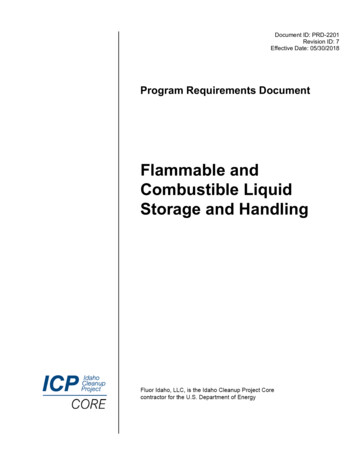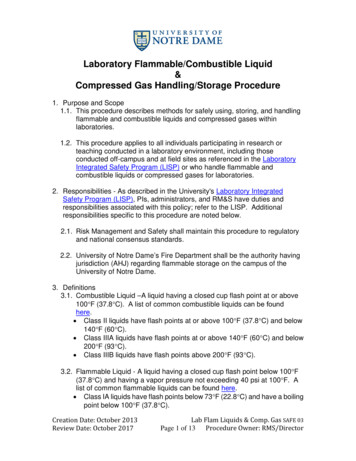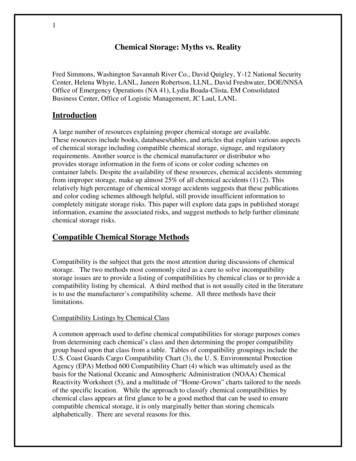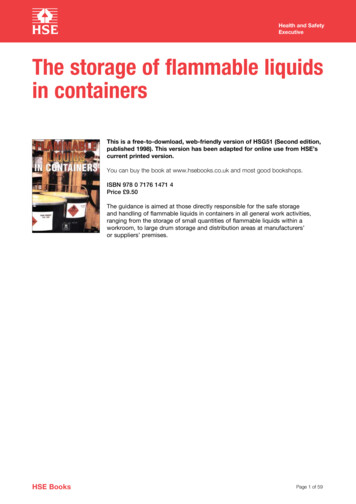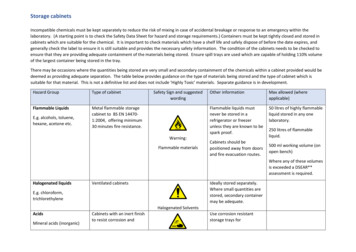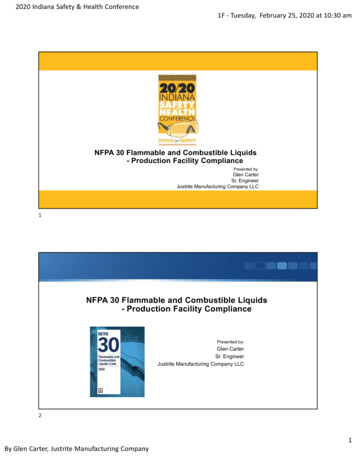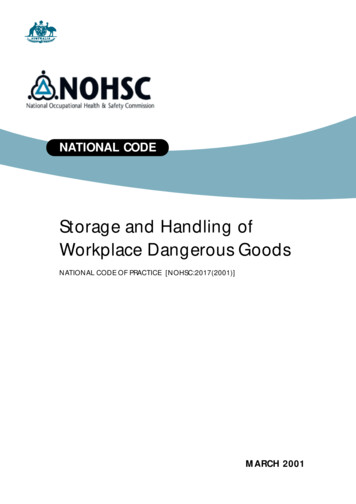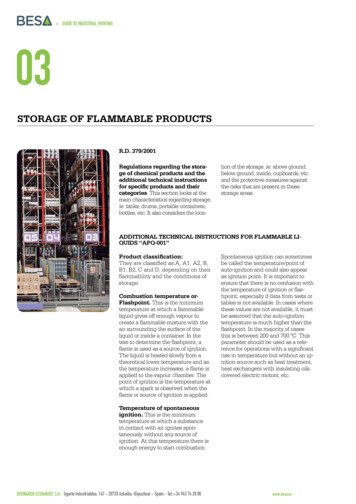
Transcription
U.S. Pipelines & Logistics (USPL)Safety ManualFlammable Liquids Storage and HandlingPage 1 of 6Flammable Liquids Storage and Handling1.PurposeThis policy establishes requirements to minimize the fire and explosion hazards associated with flammableliquids in containers and portable tanks.2.ScopeThis policy contains storage and handling requirements for flammable liquids and applies to all personnel inthe workplace who may handle flammable liquids.The following sections of the safety manual contain related policies and should be consulted for additionalrequirements and guidance:3. Electrical Safety Personal Protective Equipment Fire Protection Hot Work Hazard Communication Quality Control Test Room Safety Safety Signs and Color CodingMinimum RequirementsSupportingDocumentationMinimum Requirements1.Containers and portable tanks used to store flammable liquids shall be approved orlisted by a nationally recognized testing laboratory.Section 6.12.The use of plastic buckets to collect, store, or transfer flammable liquids is prohibitedunless the liquid would react with metal.Section 6.13.Flammable liquids shall not be dispensed into containers unless the nozzle andcontainer are electrically interconnected.Section 84.Storage in general purpose warehouses or in portions of such buildings cut off bystandard firewalls shall be in accordance with Table I, Indoor Container Storage, orTable II, Indoor Portable Tank Storage, in Appendix I.Appendix I4.DefinitionsBonding—The process of connecting two or more conductive objects together by means of a conductor tominimize potential electrical differences between the conductive objects.Closed container—A container sealed by means of a lid or other device that prevents the escape of liquid orvapor at ordinary temperatures, even if it is upset from its normal upright position.Container—Generally this policy uses the term to mean any can, barrel, or drum designed to hold less than60 gallons and meeting the requirements of a nationally recognized standard for holding flammable liquids.Issue Date: August 12, 2020Next Revision Date: August 12, 2025The controlled version of this document can be found in DRM in the HSSE Policies folder.Effective Date: August 12, 2020
U.S. Pipelines & Logistics (USPL)Safety ManualFlammable Liquids Storage and HandlingPage 2 of 6Flammable liquid—Means any liquid having a flashpoint at or below 199.4 ºF (93 ºC). Flammable liquids aredivided into four categories as follows:1. Category 1 shall include liquids having flashpoints below 73.4 ºF (23 ºC) and having a boiling point ator below 95 ºF (35 ºC).2. Category 2 shall include liquids having flashpoints below 73.4 ºF (23 ºC) and having a boiling pointabove 95 ºF (35 ºC).3. Category 3 shall include liquids having flashpoints at or above 73.4 ºF (23 ºC) and at or below 140 ºF(60 ºC).4. Category 4 shall include liquids having flashpoints above 140 ºF (60 ºC) and at or below 199.4 ºF (93ºC).Note: Previous versions of this policy referred to flammable and combustible liquids. Flammableliquids had a flashpoint below 100 ºF and combustible liquids had a flashpoint at or above 100 F.This new definition is part of a global harmonization effort, but it is important to note that differentagencies may still be using different definitions.For example, BP’s Incident Reporting requirements define flammable liquids as havingflashpoints below 73 F. The US Department of Transportation (DOT) standard 49 CFR 173.120defines flammable liquids as having flashpoints below 140 F. We have chosen the OccupationalSafety and Health Administration (OSHA) standard 29 CFR 1910.106 definition since thatregulation forms the basis for this policy. Consult the other sources, or your Safety orEnvironmental Coordinator for questions related to BP reporting or DOT shipping requirements.Flash point—The lowest temperature at which a liquid gives off sufficient vapor to form an ignitable mixturewith air.Grounding—The process of connecting one or more conductive objects to the ground to minimize potentialdifferences between the objects and the ground. Grounding dissipates an electric charge to the earth.Portable tank—Generally for this policy the term means a closed container having a liquid capacity over 60gallons and not exceeding 660 gallons, not intended for fixed installation.Static electricity—The electrification of materials through physical contact and separation and the variouseffects resulting from the positive and negative charges so formed. Static is generated when liquids move intocontact with other materials, such as in pouring, draining, mixing, pumping, filtering, or agitating.5.Roles and ResponsibilitiesA.Operations Team Leaders:1.6.6.1.Shall implement and enforce the requirements of this policy.Container and Portable Tank StorageGeneralA.Containers and portable tanks used to store flammable liquids shall be approved or listed by anationally recognized testing laboratory. These containers and portable tanks must have labels toidentify their contents and display the appropriate hazard warnings. Refer to the HazardCommunication policy for appropriate label information.Issue Date: August 12, 2020Next Revision Date: August 12, 2025The controlled version of this document can be found in DRM in the HSSE Policies folder.Effective Date: August 12, 2020
U.S. Pipelines & Logistics (USPL)Safety Manual6.2.B.The use of plastic buckets to collect, store, or transfer flammable liquids is prohibited unless theliquid would react with metal.C.Flammable liquids shall be kept in closed containers when not in use.D.Containers may be stacked if designed to do so.Storage Inside BuildingsA.Flammable liquids shall not be stored so as to limit use of exits, stairways, or areas normally usedfor the safe egress of people.B.Storage shall not be in areas occupied by offices, but may be in separate areas in storage cabinets.C.The total quantity of liquid that may be located outside of an inside storage room or storage cabinetin a building or in any one fire area of a building shall not exceed any one of the following:D.6.3.7.Flammable Liquids Storage and HandlingPage 3 of 6 25 gallons of Category 1 flammable liquids in containers. 120 gallons of Category 2, 3, or 4 flammable liquids in containers. 660 gallons of Category 2, 3, or 4 flammable liquids in a single portable tank.Storage in general purpose warehouses or in portions of such buildings cut off by standard firewallsshall be in accordance with Table I, Indoor Container Storage, or Table II, Indoor Portable TankStorage, in Appendix I. Materials that cannot create a fire exposure hazard to the flammable liquidsmay be stored in the same area.Storage cabinetsA.Flammable liquid storage cabinets shall be Underwriter Laboratories (UL) listed or Factory Mutual(FM) approved. Alternatively, cabinet manufacturers may state cabinets comply with OSHA1910.106 standards or meet NFPA 30 recommendations.B.No more than 60 gallons of Category 1, 2, or 3 flammable liquids, or no more than 120 gallons ofCategory 4 flammable liquids may be stored in a single storage cabinet.C.When used for storage of closed containers, a flammable liquid storage cabinet is not required to bevented. If the cabinet is not vented but has vent openings, they must be sealed with properly fittedmetal bungs. If the cabinet is vented, it shall be vented to a safe area outdoors in a manner that willnot compromise the performance of the cabinet.D.Cabinets shall be conspicuously labeled with the warning "Flammable—Keep Fire Away."Hoses, Piping, and ConnectionsA.Hoes, piping, and connections shall be designed for the material being handled. If low-melting pointmaterials such as aluminum or brass, or non-ductile materials such as cast iron are used in aboveground systems or inside buildings, they shall be suitably protected against fire exposure or solocated that any spill resulting from the failure of these materials could not unduly expose personsor buildings, and could be readily controlled by remote valves.B.All pressure hoses and couplings in service at loading/unloading docks shall be inspected atintervals appropriate to the service. The hose and couplings shall be tested with the hose extendedand using the “in-service maximum operating pressures.” Any hose showing material deteriorations,signs of leakage or weakness in its carcass or at the couplings shall be withdrawn from service andrepaired or discarded.C.Piping systems shall contain a sufficient number of valves to operate the system properly and tocontrol the flow of liquid in normal operation and in the even of physical damage.Issue Date: August 12, 2020Next Revision Date: August 12, 2025The controlled version of this document can be found in DRM in the HSSE Policies folder.Effective Date: August 12, 2020
U.S. Pipelines & Logistics (USPL)Safety Manual8.9.Flammable Liquids Storage and HandlingPage 4 of 6Handling Flammable LiquidsA.Employees and contractors shall wear the appropriate PPE noted in the USPL PPE Matrix whenhandling flammable liquids.B.Flammable liquids must be drawn from or transferred into indoor containers, portable tanks, andvessels only by a closed piping system, from safety cans by means of a device drawing through thetop, or from a container or portable tank by gravity through an approved self-closing valve.1.Transferring flammable liquids by means of gas or air pressure on the container or portabletank is prohibited.2.Bonding is not required where a container is filled through a closed system.C.Bonding is not required when storing flammable containers on non-conductive materials forsecondary or tertiary containment.D.Flammable liquids shall not be dispensed into containers unless the nozzle and container areelectrically interconnected, i.e. bonded.E.Flammable liquids may be used only where there are no open flames or other sources of ignitionwithin the possible path of vapor travel.F.Where flammable liquids are used or handled, except in closed containers, means shall be providedto dispose promptly and safely of leakage or spills.G.Flammable liquids with a flashpoint below 100 ºF shall not be drawn from or filled within buildingsunless provision is made to prevent the accumulation of flammable vapors in hazardousconcentrations.H.At least one portable fire extinguisher having a rating of not less than 12-B units shall be located notless than 10 feet, nor more than 25 feet, from any Category 1, 2, or 3 flammable liquid storage areainside a building.TrainingA.Personnel who work with containers and portable tanks of flammable liquids shall be trained in thesafe storage and handling of flammable liquids per the USPL Training and Competency Matrix.10. References1. Occupational Safety and Health Administration (OSHA), U.S. Department of Labor, 29 CFR 1910.106,“Flammable and Combustible Liquids.”2. National Fire Protection Association (NFPA) 30, “Flammable and Combustible Liquids Code.”Issue Date: August 12, 2020Next Revision Date: August 12, 2025The controlled version of this document can be found in DRM in the HSSE Policies folder.Effective Date: August 12, 2020
U.S. Pipelines & Logistics (USPL)Safety ManualFlammable Liquids Storage and HandlingPage 5 of 6Appendix IIndoor Storage Limits for Flammable LiquidsTable I. Indoor Container StorageCategory NumberStorage LevelUnprotected4 storagemaximum per pile (gallons)1Ground and upper floors660BasementNot permittedGround and upper floors1,375BasementNot permittedGround and upper floors4,125BasementNot permittedGround and upper floors4,125BasementNot permittedGround and upper floors13,750BasementNot permitted23 - Flashpoint 100 ºF3 - Flashpoint 100 ºF4Note 1: When 2 or more categories of materials are stored in a single pile, the maximum volume (ingallons) permitted in that pile shall be the smaller of the 2 or more separate maximum gallons.Note 2: Aisles shall be provided so that no container is more than 12 feet from an aisle. Main aislesshall be at least 3 feet wide and side aisles at least 4 feet wide.Note 3: Each pile shall be separated from each other by at least 4 feet.Note 4: Unprotected means the area does not a have an approved automatic sprinkler system orequivalent extinguishing system designed for flammable liquid storage.Issue Date: August 12, 2020Next Revision Date: August 12, 2025The controlled version of this document can be found in DRM in the HSSE Policies folder.Effective Date: August 12, 2020
U.S. Pipelines & Logistics (USPL)Safety ManualFlammable Liquids Storage and HandlingPage 6 of 6Table II. Indoor Portable Tank StorageCategory Number123 - Flashpoint 100 ºF3 - Flashpoint 100 ºF4Storage LevelGround and upperfloorsUnprotected4 storage maximumper pile (gallons)Not permittedBasementNot permittedGround and upperfloors2,000BasementNot permittedGround and upperfloors5,500BasementNot permittedGround and upperfloors5,500BasementNot permittedGround and upperfloors22,000BasementNot permittedNote 1: When 1 or more categories of materials are stored in a single pile, the maximum volume (ingallons) permitted in that pile shall be the smaller of the 2 or more separate maximum gallons.Note 2: Aisles shall be provided so that no portable tanks are more than 12 feet from an aisle. Mainaisles shall be at least 8 feet wide and side aisles at least 4 feet wide.Note 3: Each pile shall be separated from each other by a distance of at least 4 feet.Note 4: Unprotected means the area does not a have an approved automatic sprinkler system orequivalent extinguishing system designed for flammable liquid storage.Issue Date: August 12, 2020Next Revision Date: August 12, 2025The controlled version of this document can be found in DRM in the HSSE Policies folder.Effective Date: August 12, 2020
less than 10 feet, nor more than 25 feet, from any Category 1, 2, or 3 flammable liquid storage area inside a building. 9. Training A. Personnel who work with containers and portable tanks of flammable liquids shall be trained in the safe storage and handling of flammable liquids per the USPL Training and Competency Matrix. 10. References 1.
